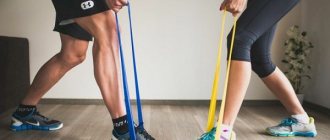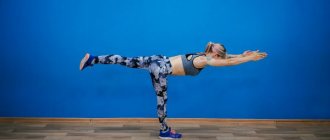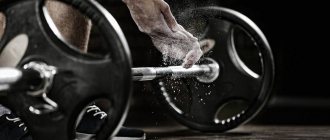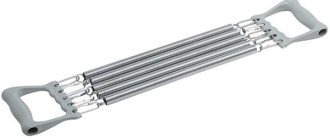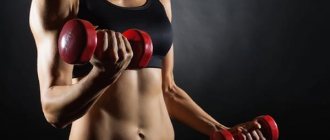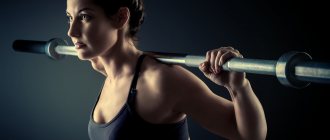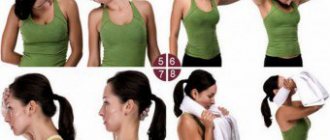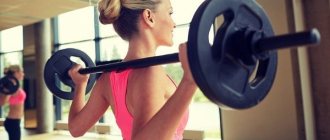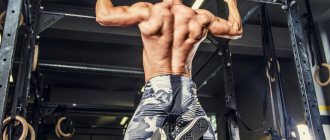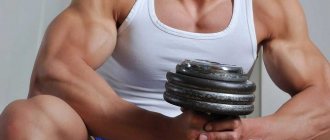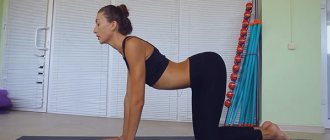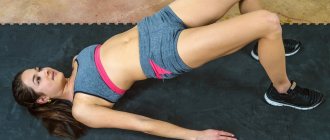BASIC EXERCISES
Outdoor exercise equipment is usually classified according to anatomical criteria, distinguishing groups of exercises with a predominant effect on different parts of the body. As evidenced by scientific data and practical experience, when compiling a complex it is necessary to be guided by the following provisions:
- The first exercises to develop are the muscles of the arms and shoulder girdle. They are usually performed at a slow pace.
- Neck exercises.
- This is followed by exercises for developing the leg muscles, alternating exercises for the leg muscles and back muscles, abdominal muscles and lateral muscles of the torso - the pelvic girdle, performed from various starting positions.
Strength exercises should precede stretching exercises.
4. The last ones in the complex are exercises that involve the main muscle groups of the whole body, performed with a large amplitude.
Finally, so-called speed exercises are used (jumping or running in place), after which the load should be gradually reduced at a slower pace. In each group, a number of exercises of a more local nature can be distinguished. For example, in the group of exercises for the arms of the shoulder girdle, there are exercises for the fingers, hands, forearms, and shoulders;
In the group for the legs and pelvic girdle - exercises for the foot, lower leg, thigh;
In the group of exercises for the torso, there are exercises for the muscles of the front or back surface of the body, etc.
The classification of exercises according to anatomical criteria is supplemented by indications of the nature of their physiological effects on the body of those involved. This refers to the predominant influence of exercises on the development of strength, speed, flexibility, and endurance.
The shape of the outdoor joint is determined by the basic movements in the joints: flexion, extension, adduction, abduction, circular movements, rotations.
The nature of the exercises largely depends on the system of muscle tension and relaxation, the speed of movements and externally manifests itself as smooth, uniform movements or movements with acceleration or deceleration, jerks, swings.
In the introductory part of the lesson, you can use specially selected games or exercises that do not require much physical stress and activate the attention of students. Based on specific conditions, the teacher must independently decide which exercises or games are most appropriate for a given lesson.
If the lesson is held in cool weather outdoors, the teacher during the introductory part should offer the most effective exercises to warm up the body. For this purpose, outdoor switchgears are carried out at a faster pace, their number increases, and therefore the duration of the entire introductory part increases. Practice has shown that to make this part of the lesson more effective and emotional, exercises with objects (jump ropes, gymnastic sticks, balls, etc.) should be used.
From a psychological point of view, the use of objects of various shapes, volumes, and masses increases the emotionality of classes, the activity and interest of children, and enriches them with new motor experience.
In connection with the above, in the examples below, exercises for various parts of the body are also grouped based on their predominant impact on the development of certain qualities.
Balance exercises
An additional set of general developmental movements in physical education for adults, which is aimed at correcting posture, includes balance gymnastics. Such exercises strengthen the muscles of the torso and increase the tone of the spinal muscles. They are performed on a raised support or on the floor, and can be done on the spot or in motion.
Exercises in place: stand on toes, on heels, turns, moving limbs, jumping.
Movement exercises: walking of various types, using weights while walking, overcoming obstacles, running, dance steps.
VARIETIES OF EXERCISES
EXERCISES FOR ARM AND SHOULDER GIRT
- Exercises for fingers and hands:
a) strength exercises:
- squeezing the tennis ball on each count;
- rest on your fingertips against the wall, standing obliquely to the wall;
Also lying down:
- pushing away from the wall with your hands, resting your straight arms on the wall, standing at a distance of a step from it;
b) exercises to increase joint mobility:
- arms up, palm to palm, fingers up, lowering the arms along the body, without changing the position of the hands;
- clapping your hands in the position of elbows to the sides, fingers forward, upward;
— lying down, transferring the weight of the body from one hand to the other, changing the position of the hands: fingers forward, inward, outward.
Exercises for forearm flexors and extensors:
a) strength exercises for flexors:
- bending your arms to your shoulders with medicine balls (dumbbells), the same with a rubber shock absorber while standing on it, grabbing the ends with your hands;
- hanging pull-ups while lying down or hanging on the crossbar, rings, uneven bars;
— while lying on your arms wide apart, bending one arm. Moving the body alternately in support while lying on the left or right hand;
b) strength exercises for extensors:
— extension of the arms (push-ups) in a lying position;
- extension of the arms while lying down, from behind with hands supporting the bench, the seats of chairs;
- jumping on hands while lying down with a clap;
- extending the arms upward from a dumbbell position to the shoulders;
c) exercises to increase mobility in the shoulder joints:
- one hand is up, the other is down. Changing hand positions with a jerk at the end of the movement;
- bringing straight arms behind the back with jerks;
- from a rest position lying behind, bending your legs, springing movements. Arms straight, fingers back;
- twist the shoulder joints, moving the stick back behind the back and back, gripping the ends. The same with the rope and shock absorber.
NECK EXERCISES
a) exercises to increase joint mobility:
- tilting the head forward, backward, to the sides;
- turns the head left, right;
- circular movements of the head;
b) strength exercises:
- hands on the back of the head, tilting the head forward and back, overcoming the resistance of the hands;
- kneeling with the head resting on the palms (on a soft support), rolling from the forehead to the back of the head;
- from a lying position with bent arms (palms at the head) and legs, a wrestling bridge (on a soft support).
EXERCISES FOR THE LEG AND PELVIC GIRL
- Exercises for the foot and lower leg:
a) strength exercises:
- raising on your toes, also with dumbbells in your hands;
- walking on toes;
— jumps on two and one legs in place and with advancements;
b) exercises to increase joint mobility:
- in the forward lunge position, springing movements, trying to touch the floor with the heel located behind the leg;
- kneeling, sit on your heels. Using springy movements, lift your knees off the floor;
- walking on the outside of the foot
Exercises for thigh muscles:
a) strength exercises:
- squats on two and one legs, also with dumbbells in hands, also with a partner on the shoulders;
- walking and jumping in a half-squat;
- kneeling, bending backwards with a straight body;
- too, but forward while holding the partner’s shins.
b) exercises to increase mobility in the hip joints:
- circular movements of the pelvis while standing with your feet apart, shoulder-width apart;
- springing movements in a wide forward lunge position. The same in the position of contribution to the side;
- bending forward in a sitting position with straight legs (legs together and apart);
- half twine, twine;
- standing on one leg, swing with maximum amplitude forward, back to the side with a straight leg;
- standing on one leg, the other resting on the bar of the gymnastic wall.
Tilts towards a straight leg.
TORSO EXERCISES
- Exercises for the front surface of the body:
a) strength exercises:
— from a lying position, raising the body to a sitting position;
- lying down, raising straight legs, raising straight legs while lying on the shoulder blades, bent;
- in a lying position, arms with dumbbells to the sides. Raising dumbbells forward.
b) exercises to increase spinal mobility:
- bend back, standing with your feet apart, hands on your belt, towards your shoulders, up;
- sitting with your lower back supported on a medicine ball.
Bend back, arms up;
- push-up bridge from a lying position.
- Exercises for the back of the body:
a) strength exercises:
- bending forward with a medicine ball held by hands on the back of the head;
- lying on your stomach, bending, arms up;
- leaning forward position, raising your arms to the sides with dumbbells;
b) exercises to increase spinal mobility:
- springy forward bends;
- Exercises for the lateral surface of the body:
a) strength exercises:
- from a sitting position, legs apart, leaning on one hand, with a turn, lying on your side, the other hand up;
- in the gray-haired position, legs apart (toes catch on the rail of the gymnastic wall or while holding the partner’s legs, bend back 45 degrees and turn the body to the right, left, hands behind the head;
b) exercises to increase spinal mobility:
- springy bends of the torso to the sides in a standing position with legs apart, hands on the belt, to the shoulders, up.
EXERCISES FOR THE WHOLE BODY
- from a crouching position go to a lying position, then again crouching at a point blank position, stand up, do the same but with bending your arms in a lying position;
- walking on your hands with the help of a partner by the legs;
- in a standing position with legs apart, circular movements of the torso;
- from a standing position, sit down with your legs crossed, without using your hands, then lie down, sit down again and stand up.
EXERCISES TO FORM CORRECT POSTURE
- from a standing position against the wall with the back of your head, shoulder blades, buttocks, and heels touching it, move away from the wall, maintaining this position. Determine the difference between the usual pose and the pose of correct posture against the wall;
- holding a gymnastic stick vertically behind your back at the lower back, take a straight body position with the back of your head and spine touching the stick. Fix the pose while standing in front of the mirror;
- standing with your back to the wall, perform squats and bend your torso to the side, without lifting your back and pelvis from the wall;
- lying on your back, hands behind your head, tense your back muscles, rise to the o.s. Maintaining a straight body position with the help of partners.
Full Body Exercises
The basis of the complex of movements for the whole body is 3 exercises:
- bar;
- squats with weights;
- incomplete bridge.
Plank
The plank is a strength exercise that puts stress on all muscles.
Find out how to improve your health: What vitamins are best for adults to take for immunity?
To perform a plank, you need to position yourself on the floor so that you support your body on your elbows and toes. You need to hold this position for 1 minute in several approaches.
Squat with weight
This exercise pumps up the muscles of the lower part: thighs, calves, buttocks. You can use dumbbells or another object as weight. For beginners, it is recommended to start squats without using weights. In this case, you cannot lift your heels off the floor; start from 10 times in several sets.
Technique:
- place your feet wider than your shoulders;
- lower yourself until your buttocks are parallel to the floor;
- slowly return to the original position.
Incomplete bridge
This exercise allows you to strengthen the muscles of the thighs and buttocks:
- lie on your back;
- lift your pelvis up without leaning on your elbows;
- hold for 30 seconds;
- fall to the floor.
DEVELOPMENT OF ORG COMPLEXES
When selecting individual exercises and compiling outdoor switchgear complexes, you must first of all be guided by who these exercises are intended for and for what purpose they will be used. In other words, pedagogical objectives should be clearly defined. The most typical forms of outdoor exercise, differing from each other in their target orientation and tasks, are morning exercises, industrial gymnastics, basic gymnastics, etc.
The forms of organization, as well as the pedagogical objectives of the classes, depend on with whom (the contingent) and for what purpose the exercises are carried out. It should be borne in mind that each exercise is universal in nature and should be used taking into account the tasks that need to be solved with the help of this exercise. For example, squats on both legs in classes with toddlers help develop a sense of balance when changing posture. Squats in morning exercises or sports warm-up warm up the leg muscles and stimulate the activity of the cardiovascular and respiratory systems. Squats during industrial gymnastics with persons engaged in labor processes involving mainly the hands or in a sitting position will contribute to the active rest of the leg muscles, especially the hip extensors. Finally, squats with dosed loads during therapeutic exercises are used to restore the functions of the muscles and joints of the legs after injuries or diseases. Externally identical exercises in form (the same squats) will have different effects depending on the nature of their execution (fast or slow squats with or without weights, etc.). In order to correctly navigate the choice of exercises, it is necessary to have an idea of the qualitatively different forms of manifestation of motor abilities. The most characteristic qualities are strength, endurance and flexibility.
STRENGTH QUALITIES. It is recommended to develop using outdoor switchgear in three ways:
- Repeated (8-12 times) lifting the available weight or overcoming the weight of your own body (during push-ups while lying down, getting up from a squat, pull-ups, etc.) until fatigue develops strength endurance and helps increase muscle mass. If repetition (8-12 times) is not difficult, it is necessary to increase the weight of the weight or change the starting position (for example, push-ups with your feet resting on a platform).
- Lifting near the maximum weight (1-3 times) develops maximum muscle strength and increases their mass. Isometric exercises (close to the limit of muscle tension with such external resistance that there is no visible movement of body parts) also develop maximum strength.
- Performing movements at maximum speed develops speed and strength qualities of muscles and speed.
ENDURANCE – using outdoor gear, they develop local and general endurance (for example, lifting dumbbells to the shoulders, pulling up on the bar).
Exercises in which many muscle groups are involved for a long time and, therefore, work with increased stress on the cardiovascular and respiratory systems, develop general endurance (for example, general impact exercises, long running in place, jumping, squats combined with bending and lying down, performed repeatedly until you sweat)
FLEXIBILITY – distinguish between active and passive flexibility. Active flexibility is associated with demonstrating mobility in the joints due to overcoming muscle work (holding a high leg, high leg swings). In this regard, the development of active flexibility involves the use of exercises with an increased range of motion, as well as exercises to strengthen the muscles that fix the joints in extreme positions (highly raised leg, high angle, etc.). Passive flexibility is the manifestation of mobility in the joints due to the force of gravity of the body’s own weight or its parts, the actions of a partner or weights (lowering into a split, bending forward in a sitting position with pulling to the legs with the help of a partner, bending the torso towards the leg with its support on the gymnastics bar walls, etc.).
Passive flexibility is developed by the method of repeated active or passive actions of a yielding nature (bending with additional movements, the same with the help of a partner), by fixing systematic positions in poses where mobility in the joints is manifested (bridge, splits, bending, etc.).
The amount of available range of motion depends on the development of flexibility. Exercising only with strength exercises leads to limited mobility in the joints and stiffness. Therefore, strength exercises must be combined with flexibility and relaxation exercises.
Relaxation exercises are also part of the outdoor training and are associated with rest and involuntary natural relaxation of muscles. Using the method of contrasting actions: alternating strong tensions and quick relaxations of a given muscle group, it is necessary for those exercising to actively or voluntarily relax the muscles. This method is effective in a lying or sitting position. Swinging movements with relaxation, shaking, and self-massage techniques are used.
Strength exercises
Strength actions are aimed at training physical strength and endurance with the participation of certain muscle groups. They are usually divided into training with your own weight and with free weight. Exercises are performed in the morning or afternoon 10 times, several times a week.
With own weight:
- push-ups;
- pull-up;
- squat.
Note! In order for the load to be distributed evenly across all muscle groups, a set of general developmental physical education exercises for adults must be done with a straight back and correct body position: put your feet shoulder-width apart, and do not lean forward.
With weights (raising and lowering projectiles):
- barbell squats;
- chest presses;
- bent over row;
- deadlift.
SELECTION OF EXERCISES
When selecting exercises based on the principle of their compliance with the main pedagogical tasks, one should be guided by the following rules:
- Exercises should have a diverse impact on those involved. This is especially important to take into account when drawing up complexes of morning exercises and sports warm-ups, which must include exercises involving the movements of all parts of the body. It is necessary to alternate exercises according to a certain pattern that makes up one series, for example, “arms-legs-torso”. There cannot be forever established rules, since the range of problems solved using outdoor switchgear is very wide.
- Along with the diverse effects on the body of those involved, outdoor gear should be selected taking into account their local influence on the development of individual muscle groups or certain physical qualities. Outdoor switchgear complexes, designed taking into account local impact, typical for athletic and basic gymnastics. The same rules should be followed when compiling a set of exercises for industrial and therapeutic gymnastics.
- The “progression” rule, widely used in sports, is also implemented when compiling an outdoor complex in the form of an “increase” in the effect of using an exercise due to an increase in the amplitude and speed of movements, the degree of tension, and the number of repetitions. This manifests itself during the performance of one exercise and one or several outdoor switchgear complexes. Each exercise can be strengthened through additional actions. An increase in load in the ORU complex is achieved by including more intense exercises in subsequent series and increasing the number of repetitions. Gradual habituation (adaptation) to the load from lesson to lesson with a constant outdoor complex indicates the beneficial effect of exercise on the body and requires a change in the complex in the direction of its complexity.
- The gymnastic method of conducting outdoor exercise is distinguished by strict regulation of movements, which is achieved with the help of clear instructions on the starting position, direction and amplitude of the movement and the nature of their implementation. When selecting exercises, you must follow the rules of gymnastic regulation of exercises. For example, when bending forward, it is important to clarify the position of the legs, since the effect will be different if the legs are placed together or apart, with toes facing out or with parallel feet. The nature of the exercise varies depending on whether the incline is performed slowly or quickly. The following exercises and their varieties should be the basis: 1. Pull-ups with straightened body bending. 2. Circular movements with your hands. 3. Squats. 4.Tilting the body forward, backward, to the side and in circular movements. 5. Tilts and circular movements of the head. 6. Lying emphasis and lying push-ups. 7. Raising the legs in a sitting and lying position (or the torso with the legs fixed). 8. Swing your legs forward, backward and to the side. 9. Jumps (jumps) multiple. 10.Walking and running in place.
Exercises to develop posture
Good posture not only makes a person more attractive, but also affects the proper functioning of all vital systems. To create an even posture, you need to perform the following exercises.
Reed:
- sit on your knees, clasp your hands above your head;
- Turn your hands palms up and pull them as high as possible towards the ceiling;
- bend to the sides;
- return to original position.
When doing this, keep your back straight and do not bend your elbows. Do it 4 times.
Worm:
- sit on your heels, place your hands on your knees;
- spread your knees to the sides;
- bend your elbows and lower them to the floor;
- tilt your head and hold for 10 seconds.
Repeat – 3 times.
METHODS OF CONDUCTING ORG
A feature of outdoor switchgear, in contrast to conducting applied exercises, is their stylization. Outdoor switchgear is carried out using objects. When practicing outdoor gear, objects are used with various efforts: as a pull-back, as a means of restoring the accuracy of movements, as a means of increasing interest in classes, etc.
A gymnastic stick is used as a limiter of movements, clarifying their direction and amplitude. In addition, it can be used as a support for exercises in supports and hangs when training with partners. Typical exercises with a skipping rope are jumping with pulling over it: on two and one leg; with rotating the rope back and forth; for each rotation of the rope and with intermediate jumps; with double rotation; in a squat, etc. A jump rope folded in half, three or four times is used as a stick. A long rope is also used for jumping while rotating its ends by two partners.
INFLATABLE BALLS are used for throwing and catching during individual and group exercises. Small (tennis) balls are also used for throwing at a target.
PUSH BALLS of different weights, as well as movement limiters and support when performing a row (for example, bending while lying down with support, your back on the ball).
DUMBBELLS of different weights are widely used as weights that enhance the effect during dynamic exercises of a speed-strength nature (light weight) and during dynamic and statistical strength exercises (medium and heavy weight). Rubber and spring shock absorbers are used for the same purpose. Block devices, weights and barbells are used for special power support in sports gymnastics and athletic gymnastics and are typical tools for outdoor training. Exercises with wooden clubs are performed to develop strength and mobility in the joints of the upper limbs, coordination of movements, and are also used in games and relay races. Many outdoor exercise routines can be performed using a gymnastic bench and on a gymnastic wall. The bench can serve as a support in a sitting position, in a lying position, or as an obstacle when jumping. Many exercises can be performed using a bench as a weight, lifting it with your hands or feet by a group of exercisers.
Thanks to the design of the apparatus on the gymnastic wall, you can perform specific exercises with your hands and feet supporting the slats at different heights, hanging and mixed hanging exercises. In addition, additional support with your hands on the wall makes it easier to perform a number of exercises (balance, squats), which is important when practicing with beginners.
It is also advisable to carry out outdoor switchgear with a partner. This expands the possibilities of using outdoor gear: the interaction of partners can facilitate or complicate a motor task, and in general increases the emotional background of classes. When drawing up a training program, you need to provide for the possibility of including exercises with objects and using gymnastic equipment in the complex.
Stretching exercises
After completing a set of general developmental strength exercises, an adult must stretch his tendons and muscles. Over the years, stretching becomes worse, in addition, strength training contributes to the shortening of ligaments and deterioration of joint mobility. Stretching exercises should be done without pain, jerking, and breathing deeply.
First, large muscle groups are pulled, then small ones.
Stretching the back and hips
Sit on the floor, make sure your back is straight, legs stretched forward. To stretch the muscles, you need to lean forward and try to reach your toes with your hands. Touch your feet and hold for 10 seconds, then straighten up. You need to lift one leg and, grabbing it with both hands, pull it up. If you feel tension, fix the position for a few minutes and change your leg.
Chest stretching
The exercise is performed in a standing position, legs should be shoulder-width apart, knees bent slightly. Place your hands behind your back in a lock. You need to slowly stretch your chest forward to the maximum, straining your stomach and back.
Outdoor Switchgear TRAINING
As a rule, outdoor exercise is not a complex motor task for those involved, and the learning process most often comes down to memorizing the sequence of exercises in a complex. The most effective other methods of teaching outdoor switchgear are the methods by showing, by telling and by division: 1. Method of teaching by showing.
When teaching outdoor gear using the demonstration method, instructions are given at the same time as to which movements are performed on what count. After 2-3 repetitions together with the group, the conductor moves on to counting and prompting. Finish the exercises with the command: “Stop!” It is served instead of the next bill.
When teaching children of primary school age, not commands are given, but orders: “Take your starting position!” etc.
2.Method of teaching through a story.
This method is used when teaching simpler exercises or in order to activate the attention of students. Along the way, suggest basic actions instead of counting, but also in the rhythm and tempo of the exercises. For example: “Bend-straighten-sit-stand.” With the combined method, combining showing and telling, the exercise is shown at the beginning, and then prompts the person to complete it.
3. Method of teaching units.
This method is used when teaching more complex coordination devices, as it allows you to make mistakes between individual movements to clarify them and correct errors. With this method, high motor density of activities is achieved.
Breathing exercises
Such exercises help you relax, lose weight, normalize digestion, and fight stress.
Palms
Take 4 deep breaths through your nose, exhale quietly through your mouth. As you inhale, clench your fists. Pause for 6 seconds and lower your arms. Shoulders and stomach are relaxed. You should do 24 sessions of 4 breaths.
Pump
While standing, bend down. In the middle of the tilt, inhale air through your nose, ending the inhalation along with the tilt. Straighten up. Repeat 12 sets of 8 breaths, taking a break for 4 seconds.
Shoulder straps
Stand on the floor, press your hands to your stomach. When performing, take 8 breaths in a row. The break is 4 seconds. As you exhale, push your hands towards the floor, straightening them. As you exhale, press your hands again. Repeat – 12 sets of 8 breaths.
A set of exercises for hands[edit | edit code]
First level
- Knee push-ups
- Push-up
- Retraction of hands with the ball behind the head
- Army press
- Rotating around your head
- Clean up
- Overhead press
- Kettlebell Bench Press
- Medicine ball rotation
Advanced level
- T-turn push-up
- Retraction of hands behind the head with weights
- Shoulder press
- Diver
- Push press
- Ball push-ups
- Push-ups with simultaneous lifting of the torso and legs
- Passing the ball
- Underhand grip pull-up
- Overhand grip pull-up
Professional level
- Ball push-ups with alternating hands
- Side push-up with simultaneous lifting of the torso and legs
- Push-up from the bar
Relaxation exercises
When performing monotonous work, a person does not notice how his muscles, while maintaining a certain body position, are constantly tense. To restore strength and calm your nerves, you need to relieve tension. For this purpose, programs have been developed that help you relax and relieve fatigue.
You need to perform the exercises with holding your breath and tensing your muscles.
For hands
Standing straight, raise your hands clenched into fists. When inhaling, first strain the muscles of the hand, then the forearm and shoulder. Hold your breath for a few seconds. In this case, you need to mentally give the command for maximum tension. As you exhale, relax, lower your arms and make several pendulum-like turns.
For the torso
Lying on your stomach, bend your whole body, raising your knees and head. Starting position, relax. Do 3-4 repetitions. The second part of the exercise is performed in the same way, but you need to lie on your back. Tighten your muscles when bending, relax, straighten up on the floor.
Oru for the muscles of the arms and shoulder girdle
The same banned issue for which Ernst fired Malakhov!
Joints and cartilage will be cured in 14 days with the help of ordinary...
Have you been trying to heal your JOINTS for many years?
Head of the Institute for Joint Treatment: “You will be amazed at how easy it is to heal your joints by taking every day...
Read more "
The muscles of the shoulder girdle and the shoulder girdle itself play an important role, as they act as a connecting link between the torso and the upper limbs. Let's take a closer look at what parts the shoulder girdle consists of, what muscles are localized in this area, and what exercises can be performed to strengthen them.
Anatomical features of the shoulder girdle
This part of the human body consists of: the collarbone, scapula, and humerus of the shoulder girdle. The anatomical structure is complemented by three joints: the humerus (is the formation of the scapula, humerus), the clavicular-acromial (lies between the collarbone and the scapula), the sterno-clavicular (is the connection of the sternum with the collarbone).
The anatomy of the shoulder girdle also names components such as muscles. It is the muscles of the shoulder girdle and shoulder that perform quite important functions, ensuring the mobility of the limbs and the shoulder itself as a whole. We will talk about them in more detail:
The deltoid muscle occupies the area directly under the skin. It covers the shoulder joint, thereby giving it a rounded appearance. The deltoid muscle performs the following functions: provides flexion, extension of the shoulder, lowering of the raised upper limb, abduction of the upper limb to the sides.
The supraspinatus muscle occupies the supraspinatus fossa and is connected to the greater tuberosity of the humerus. The supraspinatus muscle, which lies in this area, performs the following functions: shoulder abduction, retraction of the joint capsule, thereby helping to prevent impingement.
Infraspinatus muscle. It originates where the scapula bone is located, or rather, its posterior surface, connects with the large tubercle of the shoulder bone. The functions of the infraspinatus muscle are as follows: external rotation of the shoulder, retraction of the joint capsule.
Teres minor muscle. It originates on the lateral edge of the scapula. The functions of the teres minor muscle are: external rotation of the shoulder, retraction of the joint capsule.
Teres major muscle. Its tendon has a connection with the tendon of the vastus dorsi muscle. Provides the following functions: shoulder extension, displacement of the lower angle of the scapula outward, forward.
Subscapularis muscle. It originates where the subscapular fossa and the lateral edge of the scapula are located. The functions of the subscapularis muscle are as follows: rotate the shoulder inward, bringing it to the body.
Exercise therapy for neck and shoulder pain
Before developing a set of physical exercises (physical exercises) for pain in the neck and shoulders, it is necessary to find out their etiology. Mainly the muscles of the neck and shoulder girdle hurt due to osteochondrosis. For this reason, in addition to performing exercises to strengthen the muscles of the neck and shoulder girdle, it is necessary to follow other doctor’s recommendations for treatment in order to achieve a speedy recovery and eliminate pain.
Osteochondrosis in the cervical region is primarily treated with pathogenetic therapy, which helps eliminate the underlying cause of the disease. In this case, it is advisable to systematically wear a Shants collar - a means that helps ensure complete rest of the affected part of the spine and prevent microtrauma of the nerve roots. Also, the use of a collar helps to reduce the pathological discharge of nerve impulses to healthy areas, namely, to the shoulder girdle.
Therapeutic exercise is prohibited during the main period of treatment of the disease, as well as any active exercises for the muscles of the neck and shoulders. During the recovery period, after the main treatment, gymnastics is allowed, which is aimed at strengthening the muscles of the neck (shoulders). Physical techniques for the neck muscles are carried out in conjunction with breathing exercises. It is recommended to pay special attention to the trapezius and deltoid muscles, which are most often involved in the lesion, while being in a state of hypertonicity.
Gymnastics for osteochondrosis of the neck and other pathologies helps not only improve blood circulation, reduce the likelihood of pain radiating from the site of injury to other areas, but also improve a person’s psycho-emotional state. If glenohumeral periarthritis occurs, exercise therapy helps reduce the intensity of pain in the shoulder and neck and prevent joint stiffness. With the development of vertebral artery syndrome, physical exercise can help relax the muscles of the neck, shoulders, and upper limbs, and improve coordination of movements.
In addition to the benefits of exercises that strengthen and relax the muscles of the back, neck, and shoulders, there are also disadvantages, which are expressed in the presence of contraindications for their implementation. So, the following are considered absolute contraindications:
- if the person’s condition is serious and there is an increased body temperature;
- if there is a violation of the blood circulation process in the brain;
- if the symptoms of the disease progress;
- if persistent pain syndrome is observed;
- if, due to compression syndrome, surgical intervention is required.
Features of performing exercises for pain in the neck and shoulders
There is a specialized system of analytical gymnastics, which is used specifically for diseases of the spine. The main goal of a set of exercises using this system is to improve mobility in different parts of the spine and limbs. For this reason, when performing exercises, all sorts of techniques are used that will help relax certain muscle groups, increase the range of motion in the affected joints, as well as those that are involved in increasing blood flow.
The same banned issue for which Ernst fired Malakhov!
Joints and cartilage will be cured in 14 days with the help of ordinary...
When performing a set of exercises, techniques are used in a lying and sitting position. To relax the neck muscles, exercises are performed mainly while lying on your back or on your side. Let's consider an approximate gymnastics complex for relaxing the muscles of the shoulder girdle:
- Light slaps on the shoulder with the hand of the person performing the exercise.
- Swing your limbs up and down (the torso should be slightly tilted in the direction whose limb hurts).
- Starting position: lie on your back, limbs lie along the line of the body, and palms facing down. Turn your palms up and down alternately.
- In the same position, alternately lift the limbs up, and then lower them again to the line of the body.
- In the same position, alternately bend the limbs at the elbows, moving them to the side.
Now let’s look at what techniques can be used to strengthen the muscles of the neck and shoulders:
- Take a standing position with your feet shoulder-width apart. Take dumbbells in your hands, bend your elbows so that the dumbbells touch your shoulders. Return to starting position.
- In the same position, hold the limbs with dumbbells at chest level, bending the torso forward. When bending, the arms are moved to the sides.
- Place the limbs along the line of the body. Raise your arms with dumbbells to shoulder level, and then lower them down again.
- “Draw circles” with your arms extended to the sides, forward and backward.
How to prevent shoulder and neck muscle pain?
How it is necessary to prevent pain syndrome in a particular case depends only on what reason caused it or can cause it. This includes both provoking factors, for example, sitting in a monotonous position for a long time, and diseases occurring in the body.
As a rule, the prevention of pain syndrome is as follows:
- sleep on a medium-hard mattress, on a small pillow;
- performing exercises after waking up;
- if discomfort occurs in the shoulder, neck or behind the neck, it is recommended to give them rest, limiting any stress;
- If a person’s profession requires him to be in a monotonous position for a long time, it is recommended to massage his shoulders and neck from time to time.
Pain syndrome in the shoulder and neck area is mainly a consequence of muscle overstrain for one reason or another. That is why it is recommended to systematically perform those exercises that help maintain their natural mobility. Only by strengthening the muscles of the shoulder girdle can you prevent pain in the future.
2017-03-31
Severe discomfort in the shoulder is not always the result of pathology of the shoulder joint. The pain may be referred. Anyone should know this and be able to recognize the symptoms. Covering the issue of the most interesting joint in the body, it is worth noting that if it hurts to put your hand behind your back, the treatment will vary depending on what caused the pathology. Excessive stress and improper handling of the joint can last for some time, then pain develops and its functions are impaired.
Causes of pain
The human shoulder joint is considered a vulnerable point. He is unable to withstand mistreatment for long, and his response is physical illness and impaired functions. The cause of unpleasant sensations can be a variety of situations: grueling physical work, an abundance of training in the gym, the presence of viral pathologies. Severe pain often indicates a bruise, dislocation or fracture. Regular exercise should be a reason for everyone to consult a specialist; this will stop the course of the disease and its transition to a chronic form.
People at risk for pain include:
- Slouching and not paying attention to posture.
- Leading a sedentary lifestyle during the day.
- Engaged in hard physical work.
- Professional athletes.
Overload is the main cause of discomfort, so any exercise or heavy lifting provokes pain in the shoulder joint.
Possible diseases
In the first place among the causes of symptoms of the disease are glenohumeral periarthritis and injuries to the cervicothoracic spine with radicular symptoms. Their share is 80% of all cases, and 20% were divided between arthritis of the shoulder joint and arthrosis. There is also a small percentage of people who suffer from pain due to vascular disorders, stiff neck muscles, problems with the liver, heart or pancreas.
Humeral hyperarthritis is an inflammation of the tendons of the shoulder, as well as the capsule of the shoulder joint. As the disorder develops, damage to the deep internal structures of the joint and its cartilage does not occur—this makes the disease different from arthrosis of the shoulder.
Another cause may be tendinitis and subacromial bursitis, where the bursa of the same name, located between the process and the shoulder joint, becomes inflamed. Pain when placing your hand behind your back also occurs in the case of various infections: streptococcal, candidiasis, chlamydia, tuberculosis.
Arthritis is inflammation of a joint. With this pathology, severe pain is present in the right or left shoulder.
Often, unpleasant sensations overtake people whose profession involves long periods of exertion (raised arms, prolonged standing, barbell push-ups).
Osteochondrosis of the cervical spine is characterized by acute burning pain, it can radiate to the arm and intensify when turning the head, and in older people this is how degenerative processes and neuritis of the brachial nerve develop.
When the rotator cuff is damaged, pain can result from non-standard hand movements, such as painting the ceiling. After painting, the very next day a person will feel severe discomfort when moving his right or left arm back, and it will be difficult to lift it up.
Capsulitis of the shoulder joint leads to stiffness in the muscles of the shoulder girdle, accompanied by severe pain and the inability to make full movements.
Unpleasant sensations caused by injuries must be stopped as soon as possible, otherwise they will result in the formation of persistent dysfunctions of the shoulder and become chronic.
Intervertebral hernia of the cervical spine leads to intermittent aching pain in the shoulder joint and neck. Later, dizziness sets in. As the pathology develops, the situation worsens, the painful sensations become constant and unbearable.
The cause of arthrosis is considered to be old age, the occurrence of bruises, dislocations, fractures and sprains.
As a result of referred pain, sensations are felt in the shoulder, while the problem itself is located in another part of the body. A heart attack is accompanied by pain in the arm up to the elbow, a feeling of heaviness and compression in the chest, and dizziness.
Myalgia is caused by excess physical activity, hypothermia and the occurrence of viral infections. The patient feels aching, sometimes sharp pain in the muscle area, and hand movement is impaired.
An unpleasant sensation when the shoulder abducts 30–90° can cause another problem. The deposition of calcium salts due to the entry of small crystals into the subacromial bursa provokes pain similar to an attack of gout. In this case, calcification of the ligaments and tendons located under the scapula and collarbone is possible. Symptoms are typical for people 30–50 years old; in this case, the pain becomes sudden and torments the person throughout the entire pathology.
Who to contact and how to treat
Shoulder pain can be caused by many different reasons. To clarify them, high-quality diagnostics and selection of treatment strategies are necessary. The patient should visit a therapist and a neurologist. If a disease of the internal organs is detected that gives such sensations in the shoulder, you should immediately go to a specialized doctor and get rid of the underlying disorder.
Experts call for an integrated approach to treatment: stopping the cause of the disease, pathogenetic treatment that interrupts the development of pathology, eliminating symptoms and restoring joint function. By coordinating treatment tactics in each of the 4 areas, pain relief and mobility are restored in a short time and without complications.
Arthritis, arthrosis and bursitis are well treated with non-steroidal anti-inflammatory drugs and chondroprotectors. In advanced stages of the disease, you can resort to the use of hormones and narcotic analgesics to reduce human suffering. The most effective method is now considered to be joint replacement, which becomes the only solution in cases where the damage has reached a critical level.
Ice applied to the affected area helps with bruises and ligament tears. Afterwards they resort to folk remedies in the form of a vinegar compress at night.
Periarthritis is treated with analgesics and anti-inflammatory drugs introduced into the intra-articular capsule; novocaine blockade and acupuncture are also effective. If the inflammatory nature of the disease is highly pronounced, it makes sense to turn to glucocorticosteroid drugs in the form of ointments and injections.
Yoga provides positive results for shoulder pain. It helps to relax the muscles of the body, which has a beneficial effect on the body, especially on the neck and upper torso.
Electrophoresis and magnetic therapy, anti-inflammatory ointments and bischofite compresses are widely used.
Therapeutic exercise and massage of pain points strengthens the shoulder girdle, and the exercises must be compiled by a specialist who monitors the correctness and effectiveness of the exercises.
All methods used are divided into 2 groups: conservative and surgical. Conservative methods allow you to get rid of pain in most cases, this also includes drug and non-drug therapy. Sometimes the only solution is surgery.
Pain relief methods
Almost all patients complaining of shoulder discomfort are prescribed drugs from the group of non-steroidal anti-inflammatory drugs and analgesics. Medicines have two points of application: symptomatic (relieving pain, swelling and redness) and pathogenetic (reducing inflammation - the main mechanism for the development of unpleasant sensations).
Drugs with an analgesic effect in modern medicine are widespread, these are:
- Diclofenac;
- Ketoprofen;
- Ibuprofen;
- Nimesulide;
- Indomethacin;
- Aceclofenac;
- Meloxicam;
- Xefocam.
First generation medications help when severe pain occurs and the patient needs to be quickly relieved of suffering. The second and third generations are used for long-term use and chronic pain.
Prevention
To protect yourself from pain and health problems, you should evenly distribute the load while carrying heavy objects. It is better to replace a cross-body sports bag with a backpack. Movement and regular stretching and strengthening exercises are important.
You should sleep on a comfortable pillow; an incorrect position during sleep causes cervical osteochondrosis. A special elastic cushion placed under the head and an orthopedic mattress will help correct the situation.
Igor Petrovich Vlasov
- Site Map
- Diagnostics
- Bones and joints
- Neuralgia
- Spine
- Drugs
- Ligaments and muscles
- Injuries
https://youtu.be/ZHW99woDfZQ
Contents:
- What is an orthopedic pillow
- A type of orthopedic pillow
- When is an orthopedic pillow needed?
- Contraindications for use
- How to choose a good orthopedic pillow
- How to use an orthopedic pillow
What is an orthopedic pillow
So this is a product with a recess in the center for the baby’s head, which anatomically follows the shape of the child’s neck and head, and thus forms the correct position of the cervical vertebrae. Thus, such a pillow immediately performs two functions:
- Preventive.
- And provides comfort while sleeping.
Buckwheat, bamboo, or other hypoallergenic materials are used as filler in this product.
A type of orthopedic pillow
Let's talk about the varieties:
- Positional pad. This model is indicated for muscular dystonia in a child, and is specially designed for premature and weakened children, who are at high risk of developing musculoskeletal disorders. Its main function is to support correct body position, relieve stress from the spine, and prevent its deformation.
- Pillow - butterfly: completely repeats the anatomical and physiological features of the cervical-occipital region, and thus contributes to the correct formation of the cervical region and skull bones: used in the first month of birth.
When is an orthopedic pillow needed?
Considering the fact that such a pillow has a special structure and shape, it is not used for nothing, but only as prescribed by a doctor. Therefore, it is recommended to use it for a newborn in such cases as:
- Torticollis.
- Rickets.
- Cervical injuries.
- Deformation of the skull bones.
- Increased or decreased tone of the muscles of the neck and shoulder girdle.
- Uneven head.
Contraindications for use
In 60% of cases, this sleep accessory is contraindicated for a baby, as it can cause harm to the baby. The thing is that it hinders movement and limits the mobility of the child’s head during sleep, which in turn threatens with negative consequences. You should not ignore such an important factor as sudden infant death syndrome. Until 6-7 months, a child should sleep exclusively on a hard surface, but a pillow can contribute to suffocation.
Therefore, the most important contraindications for use:
- The baby is prone to frequent burping.
- The baby has problems with the respiratory system.
Thus, before purchasing, it is important to consult your doctor. After all, if a child is sick or has some abnormalities, then this issue should be resolved by a doctor who determines the treatment method, and not by a store clerk.
How to choose a good orthopedic pillow
The time has come to talk about how to choose a good product. Note that this is one of the few children's products where the first thing you should pay attention to is not the color and shape, but the correct size. After all, it is the last criterion that is of great importance.
There are certain selection rules:
- Product height: permissible rise, which does not cause harm to the spine, 30 degrees (this is no more than 4 cm).
- Type of padding: the quality of the material determines the comfort and health of the baby. If the baby is not prone to allergic reactions, then you can safely choose a natural filler. Otherwise, you should purchase a pillow filled with synthetic hypoallergenic materials.
- Availability of a quality certificate.
Categorically refuse soft, thick bedding under the baby’s head: it can easily provoke improper development of the spine, which has not yet formed. But on a hard surface it will be uncomfortable for the baby to sleep. The most suitable option is a medium-hard pillow.
How to use an orthopedic pillow
Let's imagine that you have already made your choice, now you need to understand the basics of use so as not to harm your baby. Let's take a closer look at the design of the orthopedic pillow. On one side we see a small roller, and on the other – a large one.
A small cushion is placed under the baby’s head when he sleeps on his back, but a large one is used when he sleeps on his side. Form also plays an important role. For example, if it is a butterfly pillow, then the baby's head should lie in the recess, and the lowest cushion should be under the neck. But the baby lies down on the inclined one: his whole head, shoulders.
It is worth correctly understanding that the above diseases and syndromes cannot be treated just like that: comprehensive medical consultation and proper treatment are important here. An orthopedic pillow only complements it and serves as a preventive measure. If your baby is healthy, then this product is not worth purchasing.
https://youtu.be/cZSrnquGv0c
General developmental exercises without objects
ORUs without objects represent simple movements of body parts using accessible technology, taking into account the age and anatomical characteristics of a person. Such actions help improve the condition of the body, develop physical qualities and improve health.
Complex (working the muscles of the shoulder, legs and back):
- standing on the floor, spread your legs , alternately raise your shoulders (6 times);
- without changing i. p., bend your arms at the elbows and spread them to the sides, raising your forearm. Swing your arms forward 5 times;
- add an additional step to the sides, repeat – 6 times;
- place your feet wider than your shoulders, raise your arms, bend forward, touching your heels with your hands, do 8 times;
- jumping on one leg or on two legs, copying jumping rope. Perform at a fast pace for 10 seconds.
General developmental exercises with weights (dumbbells)
Exercises with dumbbells are classified as general developmental athletic training , which are aimed at training endurance, joint flexibility, and improving body proportions. Many movements with dumbbells are performed in a sitting or lying position, which reduces the load on individual parts of the body and organs.
The main rule of such exercises is a gradual increase in resistance. In this case, the actions are performed with adding weight to the dumbbells while increasing the repetitions.
Set of movements:
- lateral bends while standing with dumbbells in hand;
- pulling a projectile from behind the head while lying on a gymnastic bench;
- alternately raising your arms with dumbbells in front of you;
- lunges and squats with dumbbells.
Corrective gymnastics exercises
Corrective gymnastics is aimed at relaxing muscles and restoring normal functioning of the body. This occurs when performing general developmental, corrective and relaxing gymnastics twice a day for 15-20 minutes.
Such exercises may include:
- a set of general developmental gymnastics exercises for adults using gymnastic apparatus;
- a series of movements without projectiles;
- group or individual lessons.
An example of such gymnastics is symmetrical exercises , which are designed to remove asymmetry, straighten the spine, and weaken muscle tone.
Exercises:
- I.p. lie on your stomach, stretch out your arms. Raise your head and shoulders, extend your arms, and move them back. Take a breath, accept and... P.
- I.p. lying on your back, raise your legs, making an angle of 45 degrees and cross your straight legs - “scissors”.
- I. p. - the same. Make circular movements of straight legs - “bicycle”.
